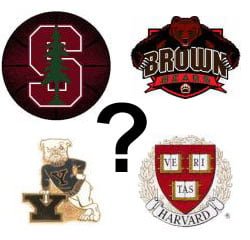~ by our Maths Faculty
My opening GMAT blog post will focus on Data Sufficiency, an important and unique Quantitative Reasoning question type in GMAT. Later on we’ll take up some sample questions to illustrate how to tackle this strange and interesting question type but first we will look at a fundamental point: why is DS important? Well, look at Figure 1 below
Figure 1
 What this pie chart tells us is that, out of 37 questions in the GMAT Quantitative Reasoning section, you can expect around 22 to 23 will be of the Problem Solving (PS) type and 14 to 15 of the Data Sufficiency (DS) type.
What this pie chart tells us is that, out of 37 questions in the GMAT Quantitative Reasoning section, you can expect around 22 to 23 will be of the Problem Solving (PS) type and 14 to 15 of the Data Sufficiency (DS) type.
Now, maybe you’re thinking that what this highlights is the importance of Problem Solving questions. But that is only the most obvious thing that the data says. The other important thing that it tells you is that if you want a good score in GMAT, you cannot afford to neglect Data Sufficiency. On the contrary, DS questions play a crucial role in converting mediocre GMAT scores into first-rate ones, so, if you ignore DS questions, that great GMAT score you are looking for may never be yours. Here’s why.
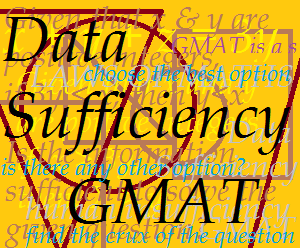 When you are through with your initial preparation and have given 3-4 mock GMAT tests, like most other students, you will probably find your scores stagnating. There are various reasons for this, but, in Quant, if you find that your raw score is fluctuating between 43 and 46 out of 60, the reason will usually be low accuracy in DS.
When you are through with your initial preparation and have given 3-4 mock GMAT tests, like most other students, you will probably find your scores stagnating. There are various reasons for this, but, in Quant, if you find that your raw score is fluctuating between 43 and 46 out of 60, the reason will usually be low accuracy in DS.
The most important reason why many students don’t achieve high accuracy in DS is that they don’t think the way that DS demands. We never solve such questions either in school or in college so, we don’t really understand them and so, we end up ignoring or trying to avoid DS questions. But that, is a big mistake! Remember the stats: you can’t think of getting a good score in GMAT without mastering DS questions. So, how do you deal with the difficulties that this question type throws up? Watch for our next post and find out.
~ By our Quantitative Reasoning Faculty
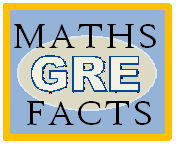
April is almost over and the countdown to the exam has already begun. You want a good overall score and if you’re an engineer, you are most probably thinking that getting 165 on Quant shouldn’t be too much of a problem (the typical engineer approaches maths questions with a raw “Just bring ‘em on” kind of arrogance and usually gets most questions right). But here’s the problem: sometimes even those with a strong background in maths may not cross the 160 mark – and when that happens, dreams of a score in the 325+ range come crashing down. To prevent that unhappy outcome, here are some basic insights about the way the math works on GRE.
One fundamental reason why some students don’t get the scores they should, is that they simply don’t understand the way the exam ‘TALKS’ maths. What this means is that the GRE test has its own way of defining mathematical terms. If you don’t understand the definitions used in the GRE exam, then time and time again you are going to end up making errors on questions you should have got right – and you are likely to end up feeling frustrated and demoralized. So, let’s have a look at a few basic differences between Indian maths and American math.
1. The First Surprise – GRE Numbers are neither Natural nor Whole!
In school (for us in India), the basic classification of numbers is this:
- Natural Numbers – {1, 2, 3, 4… ∞}
- Whole Numbers – {0, 1, 2, 3…∞}
- Integers – {-∞…,-1, 0, 1…∞}
- Fractions – p/q, q≠0, p, q e integers
But ETS never uses the term ‘Natural Numbers.’ They refer to these numbers as ‘Positive Integers’. Also, you won’t find the term ‘Whole Numbers,’ instead, ETS uses the term ‘Non-Negative Integers’. What you need to catch here is that in Quant, the negation of a negative is not always positive. It is either positive or ZERO!
2. Some More Surprises – Oddly Enough with Even Numbers, and Even with Odd Ones
Let’s have a look at a few other definitions that we learnt in school (and went by for years):
- Even Numbers – {2, 4, 6, 8…} in short, numbers which are divisible by 2
- Odd Numbers – {1, 3, 5, 7…} in short, numbers which are not divisible by 2
But when it comes to GRE, the definitions have a twist! According to ETS:
- Even Numbers – {…-8,-6, -4, -2, 0, 2, 4, 6, 8…}
- Odd Numbers – {…-7,-5, -3, -1, 1, 3, 5, 7…}
That means in the GRE exam, if the question says “x is an even number”, then you cannot really assume that ‘x’ has a positive value. In fact, you should remember that ‘x’ can be either positive or ZERO or NEGATIVE! The same rule applies to odd numbers as well.
3. One More Thing to Factor in – Along with Multiple Problems
Similarly, if you were asked to list the factors of 10, your answer would be {1, 2, 5 and 10}, which would be fine in an Indian exam. In the GRE, however, this would be regarded as an incomplete (and therefore wrong) answer. The reason is that the ETS expects you to consider the negative factors as well! Hence, in the GRE the correct statement of the factors of 10 would be:{1, 2, 5, 10,-1,-2,-5 and -10}.
The same is true when listing multiples as well, i.e., if you are asked to enumerate the multiples of 5, your answer set should contain {…-15,-10,-5,0,5,10,15…} and not {5,10,15,20…} only!
So, now are you ready for this?
Now that you have the necessary ‘inside information,’ you should be! So, try solving this question:
How many positive integers, less than 20, are either an even multiple of 2 or, a multiple of 9 or, the sum of a positive multiple of 2 and a positive multiple of 9?
Let’s see how many integers you can come up with! (see answer here)
We present you the definitive guide to University Selection for MS in US. One of the most difficult and important parts of the whole process of applying to American universities is deciding which ones to apply to. And considering the large number of good universities and the wide variety of courses available, selecting the right universities is a difficult exercise. So, here are a few pointers to help you on your way.
You need to begin with a clear statement of what you wish to study and what your career goals are. Another approach is to first define your future career goals and then think about what academic degrees you would need to achieve your career goals. These should guide your choice of institutions. A list of institutions that meet your broad criteria could be prepared by:
- a search of university websites, which is the most authentic and current source of information about universities and colleges in the US – what they courses they offer and what research they carry out etc.
- consulting seniors already in US universities
- consulting those of your teachers who are well-informed about current developments and courses
- looking up sources such as Petersons.com.
Popular discussion forums and other web resources can be unreliable since the details reported are often based on personal opinions of students which are unverifiable.
Once you have a list of 25-30 accredited institutions that offer your field of study and the specializations that you are interested in, you will need to compare the objective data for these institutions (see bulleted list below). Do not rely solely on rankings or ratings of institutions; there is more to choosing the right department than choosing the most well-known or elite university.
For any particular discipline there will be about 10 to 15 schools that have excellent reputations. Keep in mind that a department’s reputation relies heavily on the reputation of its faculty and the research projects they are doing. Sometimes it is more important to study under a particular person than it is to study at a university with a prestigious name. Also remember that assistantships and fellowships are often based on the right “match” between student and faculty research interests. An in-depth advance study of these aspects can help you find the schools whose departments and faculty meet your academic and professional goals, and it may enhance your chances for obtaining financial assistance.
Make a comparison chart listing the universities which you had selected with respect to:
- core courses and electives offered
- research projects and facilities
- size of the department (intake of students and number of faculty)
- cost of tuition, fees, books, etc.
- availability of financial assistance
- location, housing options, campus setting, climate, and cost of living
- course and thesis requirements
- length of time required to complete the degree
- admission requirements, including required test scores and undergraduate grade point average
Narrow your choice of universities to those that:
- meet your personal and professional needs
- you can afford to attend and
- you are qualified for admission.
Develop a final short list of eight to ten universities to which you plan to apply. Once your final list of universities is decided, you are ready to start the application process.
Related Posts
- Key Steps, Crucial Decisions, Vital Information for Applying for an MS or PhD in the US
- How to Crack the GRE
- Key Facts about TOEFL and IELTS
If you are applying for fall 2014 the clock has begun to tick. So, don’t delay. Review this Application Timeline for Fall 2014 immediately and get to work. Here it is:
June-August 2013 – Review you goals for MS education and choose some specific areas in which you would like to specialize.
July 2013
- Register for the GRE and TOEFL examinations – these examinations should preferably be taken by September.
- Register for the Subject GRE– important for doctoral programs in pure sciences, the biological sciences and master’s programs in computer science in top schools.
Note: the exam is held once in a year in November, however, seats usually get filled up by August.
August 2013 – Make a preliminary list of about 30 universities which meet your requirements considering:
- Location
- Costs
- Broad specializations you are interested in (for departments and specializations see the ‘university info‘ page on online.dilipoakacademy.com)
- Recommendations by seniors, your professors etc.
- Whether your academic profile fits the universities requirements.
September 2013
- Arrange for 10-13 sets of transcripts in sealed covers from your college or university – some universities insist on university transcripts
- Choose your recommenders (generally 3 recommendations are required, at least one of which should be from the educational institute last attended) and give them the necessary details – resume, copies of your mark sheets etc.
- Start working on your Statement of Purpose (target date for completion 31 October 2013) and resume
October-December 2013
- Take the GRE and TOEFL exams latest by 20 December
- Carry out a comprehensive review of the 30 universities considering:
- Your academic performance in bachelor’s degree
- GRE and TOEFL scores of students admitted in the past
- Any minimum cut-offs with respect to GRE and TOEFL scores
- Whether courses of your choice are offered in the Fall semester
- Cost of education
- Make your final shortlist of 8-10 universities.
- Complete your Statement of Purpose (SOP) and resume
- Request the ETS to forward your GRE and TOEFL scores to the universities you are applying to, specifying the correct codes for the universities/departments you are applying to.
Note: some universities require certain documents to be sent to the department you are applying to
- Complete online application process and send the required documents by courier
This completes the application process; however there are further steps to be taken:
- Track the status of your application on your status page of the university’s website. Though universities generally communicate decisions or requirements by either e-mail or post, it often happens that the only source of information is your status page.
- If there are any deficiencies in your applications (missing documents, non-receipt of GRE or TOEFL scores, recommendations etc.) act immediately to correct the deficiencies.
- When you receive an offer letter from the universities (or when an admission decision is indicated on your status page) email your acceptance. This is very important especially when you are offered funding.
- When you have accepted the university’s offer of admission and the documentation formalities are complete the university will send you the 1-20, an immigration document, which is essential for obtaining a visa.
- When you receive the I-20, check that it is correct in all respects:
- Your name and date of birth should be exactly as in your passport
- Your course and course duration are correctly specified
- The financial sources indicated exceed the costs etc.
- Prepare the visa documentation
- Study the visa application formalities specified on the websites of the applicable US Consulate and the VFS (Visa Facilitation Services)
- Apply for a visa interview date – you can apply for a visa interview 130 days before the joining date mentioned on your I-20.
For further details on the F-1 visa see our previous blog on the subject.
Announcing the ‘Best Online Tool for Applying for an MS in the US’!
Here’s some terrific news for all of you who are applying for admission to US universities” – Dilip Oak’s Online, a fantastic resource launched by Dilip Oak’s Academy puts vital help at your fingertips.
Here’s a peek at what makes it so cool:
- US University Information and Document Checklist Feature – an invaluable list of the departments and courses available in the top 220 universities; included is a checklist to help you keep track of which application documents you have or need – get a check list for every university you apply to. This is a treasure trove of information all conveniently collected in one place! (Read more below)
- Question & Answer Forum – a community of advisers that you can turn to and clarify all your doubts relating to the admissions process for American universities (Read more below).
- Application Tracker – a handy app that allows you to monitor the status of your applications (going to apply, applied, admitted…) for every university – view the status of all universities on one convenient page (Read more below).
- Full-length Online GRE Practice Tests in the Revised Pattern – 4 are already available!
- Dilip Oak’s Blog – important news, advice and updates on standardized tests and student meets along with inputs from our past students and professionals in various fields – right on this site!
More exciting features are also coming soon:
- Online Admission Center Services – expert personalized guidance for every aspect of the admission process (Read more below)
- Visa Tips – help to tackle the last and most important obstacle – the visa interview! (Read more below)
1. US University Information Feature
Can’t find information about US Universities? It’s available – in the DOA Online site!

Cut your university research time in half by, selecting a university and looking up the departments, the programs available and the check lists for the top 220 universities. Why go to 220 different websites when you can simply sign up and get all the information here?
And if you find it difficult to keep track of which documents you have for which universities and which ones you don’t, the document checklists for each university will help you to see whether your set of application documents for every university is complete or not.
Also, get deadlines for every university.
2. Question & Answer Forum
Do you have doubts about US universities and admissions? Find out what you need to know right here.
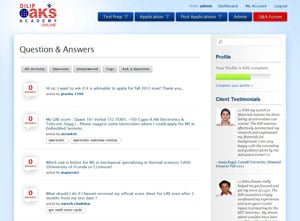
Our Q & A forum allows you to link in to a community of advisers who will guide you on all admissions-related issues – courses, universities, documents and deadlines and so on. Sign up, post questions and cut the confusion. This resource is what you need to get clarity.
3. Application Tracker
Is it difficult to keep which universities you are applying for and which ones you are not? You’ll find our University Applications Tracker so helpful. With it you can see exactly what stage you are at for all the universities you have selected.
![]() The Applications Tracker will help your application efforts get organized.
The Applications Tracker will help your application efforts get organized.
4. Full-length Online GRE Practice Tests in the Revised Pattern
Need good online practice for the GRE Test? Full-Length revised pattern mock GRE tests are just a click away.
Features:
- full-length revised pattern tests – with essay section
- detailed explanations for all questions
- personalized feedback on your essays
- scores on the new scales
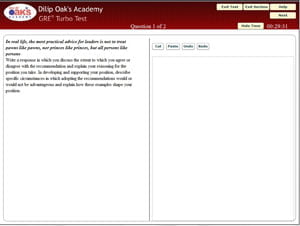 With the Oak’s Online GRE Tests you can prepare to be successful!
With the Oak’s Online GRE Tests you can prepare to be successful!
1. Online Admission Center Services
Does getting admission to a US university seem like a difficult task? Let the experts help.
So far, Dilip Oak’s Admission Center has helped 17,000 students to get admission to good US universities. With 15 years of experience in the field, we can guide you through the complex year-long process to the right university for you. Benefit from our expertise. It will give you a valuable edge as you prepare SOPs, transcripts, financial documents and in every aspect of application process. We are your one-stop shop for admission to US universities
2. Visa Tips
Worried about the Visa Interview? We’ll Help You Prepare
Being well prepared for the dreaded visa interview makes a big difference. We have years of experience in helping students get ready for the visa interview. We’ll help make the process smoother for you.
- We’ll tell you the questions
- We’ll help you frame convincing answers
- We’ll help you prepare flawless documentation
- We’ll take you through a mock interview
With our help you can have the confidence that comes with good preparation

